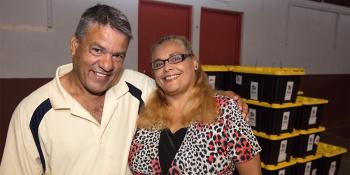Families in Puerto Rico receive shelter repair kits
The tin roof is gone, exposing gray clouds overhead. There’s no telling where the windows that opened onto a landscape of banana and plantain trees landed.
Still, Lizette stands in the front room of her house high on the Puerto Rican hills of Caguas and sings. Her voice, steady and strong, fills the air with the Spanish chorus of a song that translates:
“You can have peace, peace in the storm. Beautiful hope, when you just can’t go on. Even when your world is in pieces, the Lord will guide your steps, with peace, peace in the storm.”
On Sept. 20, Hurricane Maria devastated Caguas, a large, mostly rural city in central Puerto Rico. Heavy rains and 170 mph winds wiped out roads, power and water. More than 5,000 homes were severely damaged. The houses on the hills where Lizette lives were among the hardest hit.
While its eye traveled directly through Caguas, Maria pummeled every part of Puerto Rico. In the weeks since, Habitat for Humanity Puerto Rico has been scaling up its response. For starters, Habitat and Save the Children have begun distributing 2,000 shelter repair kits in communities across the island. The tools and supplies inside are helping families make critical repairs to their homes.
“We are here for the long run,” says Jaime Fonalledas, Habitat Puerto Rico board chair. “We are going to build homes and we are going to make lives better for the people of Puerto Rico, but we wanted to do something that impacted the people immediately.”
For Lizette, the contractor-grade tarp in the shelter repair kit is a godsend. She and her husband, Rafael, are using it to shut out the sky and begin the process of cleaning up and rebuilding. She was delighted to discover the flashlight and radio. Like many Puerto Ricans, Lizette has been without power since Hurricane Irma hit in early September and is being told that it could be summer before the lights come back on. “Today I went to buy some groceries — no matches or flashlights or candles,” she says. “I went to three places.”
The shelter repair kit comes with something else that is even more important than a tarp and flashlight, Lizette says. “When people look at the kit, they see items and tools. But I see hope — hope that will help us find a way to build our house again.”
On a recent stormy morning in Caguas, 500 families — from mothers with little children to older people with walkers — filed into the Roger Mendoza Coliseum to pick up their shelter repair kit and attend a demonstration on how to use the 22 items inside. The 5-gallon bucket for carrying water and crushed concrete, the 21-inch bow saw for clearing fallen limbs and the 100 feet of braided rope for securing the tarp are integral to getting people back to their homes and lives, says Caguas Mayor William Miranda Torres. “This help is bigger than anyone can say.”
The city is concentrating its efforts on getting the roads passable and the utilities back up and running. Meanwhile, the roofs of an estimated 2,000 homes were either badly damaged or blew away altogether. “I know that with this help, we can move a little faster to help people be in their house again,” the mayor says. “That brings hope. If you ask me how important that is, I don’t have the word.”
Lizette can’t wait to move back into her house on the hillside. Joy, happiness and love are words that she uses to describe it before Hurricane Maria. “We want to rebuild because this is our home,” she says.
She gives a tour of the house on the top floor of a two-story building. “It was not big, but it was very comfy for us,” she says. “This used to be my living room. This was my kitchen. This used to be my bedroom.” She loves its view of the valley below. “But with windows,” she says.
For five hours, Lizette and Rafael rode out Hurricane Maria in the bathroom of their relatives’ house next door, which is lower to the ground and where they currently are living. “The wind sounded like someone was screaming. It was terrible, terrible, terrible,” Lizette says. “The next day, when we opened the door and saw what happened, I said, ‘My God.’”
While Hurricane Irma took their power, Hurricane Maria got the water. “You get used to flushing your toilet,” Lizette says. “You get used to washing your dishes, washing your clothes. Now you have to go to the river.”
Lizette had wanted to flee to the states, but Rafael said no. “He said, ‘We are not going to run away. We are going to stay together and start all over.’”
And that’s what they are doing, starting with the hole in the roof. And singing. “I used to sing,” Lizette says. “And I still do.”

